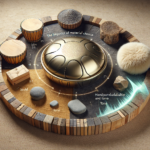The handpan, a captivating and relatively new musical instrument, has taken the world by storm with its enchanting, ethereal sounds. Musicians and enthusiasts alike are drawn to its unique sonic qualities and meditative tones. While the instrument itself is often played with the hands, incorporating mallets into your handpan playing can open up a whole new world of sonic possibilities. This article explores how handpan mallets can transform your sound, allowing you to master dynamics and enhance your musical expression.
The Basics of Handpan Playing
Traditionally, the handpan is played using the hands and fingertips. This approach allows for a wide array of tones, from soft, gentle taps to more forceful, resonant strikes. The handpan’s design, featuring a series of tuned notes distributed around a central dome, allows players to create melodies, rhythms, and harmonies that are both intricate and soothing.
Playing with the hands offers a direct and tactile connection to the instrument, enabling nuanced control over dynamics and articulation. However, some players seek to expand their expressive palette beyond what can be achieved with the hands alone. This is where handpan mallets come into play.
Introducing Handpan Mallets
Handpan mallets are specialized beaters designed specifically for playing the handpan. They are typically made with a combination of materials, such as rubber, felt, or silicone tips, affixed to wooden or synthetic handles. These mallets are engineered to produce varied sounds and textures, allowing players to explore different dynamic ranges and timbral qualities.
One of the key advantages of using mallets is the ability to achieve a more consistent and focused sound. While playing with the hands can result in a rich and organic tone, it can sometimes be challenging to maintain uniformity, especially in fast, complex passages. Mallets provide a more controlled and precise attack, enabling players to produce clear and articulate notes with ease.
Exploring Dynamics
Dynamics refer to the range of volume levels in a piece of music, from soft (pianissimo) to loud (fortissimo). Mastering dynamics is crucial for adding emotional depth and expressiveness to your playing. Handpan mallets offer a unique way to explore and manipulate dynamics, allowing you to create lush crescendos, delicate decrescendos, and everything in between.
When using mallets, the force of your strike and the type of mallet tip you choose play a significant role in shaping the dynamics of your sound. For instance, a soft rubber tip will produce a more muted and mellow tone, ideal for gentle, introspective passages. On the other hand, a harder silicone tip will yield a brighter and more projected sound, perfect for powerful, energetic sections.
By experimenting with different mallet types and varying your playing technique, you can master a wide spectrum of dynamic levels, enhancing the emotional impact of your music. This dynamic versatility can be especially valuable in ensemble settings, where blending and balancing with other musicians is essential.
Tonal Colors and Textures
Handpan mallets also offer the opportunity to explore a diverse array of tonal colors and textures. The material and design of the mallet tip can significantly influence the character of the sound produced. For example:
- Felt Mallets: These mallets produce a warm, rounded tone with a soft attack. They are excellent for creating smooth, flowing melodies and lush harmonies.
- Rubber Mallets: Rubber-tipped mallets offer a more defined and slightly percussive sound. They are great for adding rhythmic drive and accentuating individual notes.
- Silicone Mallets: Silicone tips provide a bright, clear tone with a precise attack. They are well-suited for intricate passages and fast, articulate playing.
By switching between different mallet types, you can paint your music with a wide range of tonal colors, adding depth and variety to your performances. This versatility can be particularly beneficial in solo handpan compositions, where creating contrast and maintaining listener interest are key considerations.
Advanced Techniques
Beyond basic strikes, handpan mallets enable the exploration of advanced playing techniques that can further enrich your sound. Some of these techniques include:
- Rolls: By rapidly alternating strokes between two mallets, you can create sustained, tremolo-like effects that add a sense of continuity and flow to your music. Rolls are particularly effective for building tension and creating atmospheric textures.
- Flams: A flam is a percussion technique where one mallet strikes the surface slightly before the other, producing a subtle yet distinctive double-hit effect. Flams can add rhythmic complexity and enhance the phrasing of your playing.
- Glissandi: Glissandi involve sliding the mallet tips across the surface of the handpan, generating sweeping, gliding sounds. This technique can evoke a sense of movement and fluidity, enriching the overall sonic landscape.
Incorporating these techniques into your playing can elevate your musical expression, enabling you to create captivating performances that capture the listener’s imagination.
Choosing the Right Mallets
Selecting the right handpan mallets for your needs involves considering several factors, including your playing style, the sonic qualities you wish to achieve, and the design of your handpan. Some key considerations include:
- Mallet Tip Material: As discussed earlier, different tip materials yield different tonal characteristics. Experimenting with various materials can help you find the ones that best complement your musical goals.
- Handle Length and Weight: The length and weight of the mallet handle can impact your playing comfort and control. Some players prefer longer, balanced handles for better reach and leverage, while others may opt for shorter, lighter handles for agility and precision.
- Grip and Ergonomics: The grip and ergonomics of the mallet handle are important for ensuring a comfortable and secure hold. Look for mallets with textured or contoured handles that fit naturally in your hand, reducing strain during extended playing sessions.
Ultimately, the best way to find the right mallets is through trial and error, experimenting with different options and observing how they influence your playing experience.
Conclusion
Handpan mallets offer a powerful and versatile tool for expanding your musical horizons and mastering dynamics. By incorporating mallets into your handpan playing, you can explore a rich palette of tonal colors, textures, and dynamic levels, enhancing your overall musical expression. Whether you are a seasoned player or a newcomer to the handpan, experimenting with mallets can unlock new creative possibilities and help you transform your sound in profound ways.
FAQs
1. Can I use regular drumsticks or mallets on my handpan?
While it is possible to use regular drumsticks or mallets, they may not be optimized for the delicate nature of the handpan. Specialized handpan mallets are designed to produce the best sound while preserving the instrument’s surface. Using inappropriate tools can cause damage or produce suboptimal tones.
2. How do I care for my handpan mallets?
Proper care for your handpan mallets involves storing them in a safe place, away from extreme temperatures and humidity. It’s also important to periodically inspect the mallet tips for wear and tear, replacing them as needed to maintain optimal performance.
3. Are there any techniques specific to using mallets on a handpan?
Yes, several techniques are unique to mallet use, including rolls, flams, and glissandi. These techniques can add rhythmic complexity, dynamic variation, and unique textures to your playing. Experimenting with these approaches can greatly enhance your musical expression.
4. Will using mallets wear out my handpan faster?
When used properly, handpan mallets designed specifically for the instrument should not cause significant wear. It’s important to use mallets with appropriate tip materials that are gentle on the handpan surface. Avoid excessive force or techniques that may damage the handpan.
5. Can beginners use handpan mallets, or are they only for advanced players?
Both beginners and advanced players can benefit from using handpan mallets. For beginners, mallets can provide a more consistent and precise sound, aiding in developing a foundational understanding of dynamics and tone. Advanced players can explore the advanced techniques and dynamic control offered by mallets.





